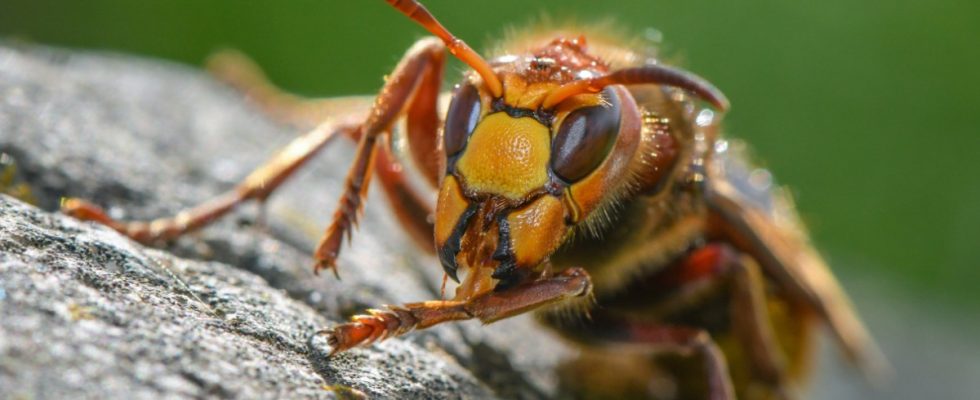Hornets don’t exactly have the best reputation. Wrongfully so, because the large, striped insects are usually relaxed; it is not for nothing that they are called “gentle giants”. Unless you get too close to their nest, the animals can of course defend themselves. In Germany, hornets are listed as a specially protected species in the Federal Nature Conservation Act; their peoples must not be killed. But according to the latest research, their populations are declining sharply. Cleared landscapes, the decline of habitats and additional persecution by humans – all of this is causing a decline in the species population. To make matters worse, the hornets are also plagued by illness.
There are still persistent legends and myths surrounding these actually peaceful animals. A widespread belief is that it only takes three hornet stings to kill a person. A misconception, confirms entomologist Julia Schmack from Freising. Hornets are completely harmless to a person who is not allergic to the poison. “The hornet’s venom is no stronger than that of its smaller stinging relatives, but it does contain acetylcholine, a neurotransmitter that causes pain,” explains Schmack. Since the stinger of a hornet is longer than that of a honeybee, it can penetrate deeper into the skin – which in turn can make the sting more painful, explains the ecologist.
Experts relocating hornet colonies noticed that actually healthy colonies were collapsing, describes Julia Schmack. “The experts found dead animals that looked fungal.” So we started looking for clues together with the Bavarian Nature Conservation Association. Julia Schmack, as a scientific expert, helped to narrow down the possible pathogens. “From the group of wasp and hornet consultants, hornets that were found dead were first frozen and a sample of eleven hornets from ten colonies was handed over to the laboratory of the Bee Health Service in Poing for examination,” explains Schmack.
The finding: The dead hornets were infected with a disease. The wing deformation virus, also called Deformed Wing Virus or DWV for short. Insects severely affected by the infection die within a few days. Latent infestation results in malformation of the wings – which contributes to the name of the disease.
Actually, this virus is strongly associated with bees and has been known for years. “However, this infestation has become more widespread since the Varroa mite spread as an ectoparasite on honey bees and carriers of the virus,” says Schmack. Beekeepers therefore regularly treat their colonies against this mite. However, the most recent observations and research assume that pollinators of all kinds can become infected with DWV. However, according to various research, it is ruled out that transmission via pollen causes hornets to become infected with the virus.
The hornets become infected with the virus through captured honey bees
“We assume that the hornets become infected with the virus by eating infected honey bees. Hornets are the natural enemies of honey bees and other, mostly wild, insects, which they hunt and feed to their young,” says Julia Schmack . She herself suspects that hornets are finding fewer wild prey due to a decline in insect diversity. “Beehives with their many, often quite tame, bred individuals are the ideal place to capture many animals at once.”
And flightless honey bees infected with the deformed wing virus are particularly easy prey. “Here the hornets then become infected with the virus,” says Schmack. As a result, livestock farming may pose a further challenge for the already endangered hornets, she suspects. “Honey bee colonies that are not regularly treated for the Varroa mite, the vector of DWV, can represent a source for DWV and numerous other pathogens.” That’s their theory. Because there are still too few studies on the topic. Even the effects of the virus on the hornets have not yet been sufficiently researched, explains the entomologist. “It’s interesting that the virus has been detected in many insects, but the animals are not harmed.”
Factory farming can always have negative effects
The extent to which the virus infestation is responsible for the decline in hornet colonies must be clarified in future research, says Julia Schmack. In general, the question of hornet and insect deaths is more complex than a single virus. It is often the interaction of various stress factors, such as changes in the climate or loss of habitat, that affect the animals. This in turn eliminates the need for beneficial insects that in turn protect the insects against certain pathogens, explains Schmack. “Viruses and bacteria then have an easier time infecting the animals; they are then often presented as the only trigger, although they are usually just the straw that breaks the camel’s back.”
The ecologist therefore appeals to use consistent strategies that protect insects from pathogens and at the same time help to create natural habitats. “The campaign worked wonderfully for the bees and their stings are just as painful.” This commitment must be given to all insects. It must also be understood that factory farming of any kind can have negative effects – diseases could, as in the case of DWV, spread quickly and be transmitted to other animals. In this case, the ecologist appeals for honey bees to be consistently treated against the Varroa mite.

